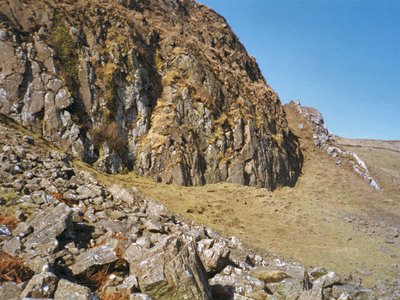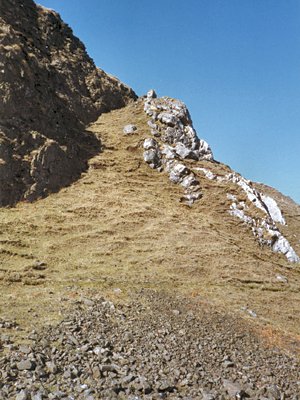Earth Science Conservation Review
| Scawt Hill | Antrim |

| Site Type: | Crag, Crags |
| Site Status: | ASSI |
| Council area: | Larne Borough Council |
| Grid Reference: | D338090 |
| Google maps: | 54.91115,-5.91368 |
| Rocks | |
|---|---|
| Rock Age: | Tertiary, Cretaceous (Eocene, Palaeocene, Santonian) |
| Rock Name: | Lower Basalt Formation, Ulster White Limestone Formation |
| Rock Type: | Basalt, Dolerite, Limestone |
| Interest | |
| Minerals: | Afwillite, Analcime, Bredigite, Calcite, Cebollite, Ettringite, Gehlinite, Grossular, Gyrolite, Hydrocalumite, Hydronephelite, Larnite, Merwinite, Natrolite, Okenite, Pectolite, Perovskite, Plombierite, Portlandite, Rankinite, Scawtite, Spinel, Spurrite, |
| Other interest: | plug, Contact, Intrusion, The site was previously declared as part of a much |
Summary of site:
Scawt Hill is the dominant feature on the skyline admired by northbound travellers on the Antrim Coast Road as they turn west at Ballygalley Head towards Ballygalley. It was made famous between 1929 and 1933 by C. E. Tilley in a series of classic scientific papers describing its unique mineralogy and geological setting.
Scawt Hill is a volcanic plug (the central cylindrical feeder of a volcano, in which the molten rock has solidified). The volcano has long since eroded away and the hill now exposes its roots. On its way to the surface the molten basaltic rock passed through the Cretaceous Ulster White Limestone (an exceptionally pure limestone), and it was the reaction between the molten rock and the limestone that created the extraordinary variety of minerals.
The reaction had three main components: 1, the effect of heat alone on the limestone; 2, the penetration of high temperature solutions of complex chemistry from the melt into the limestone; and 3, the assimilation of limestone forming the wall of the volcanic feeder into the molten rock of the margin. The mineral assemblages at Scawt Hill demonstrate actual chemical and mineralogical relationships that had previously been anticipated in theory alone.
Scawt Hill has yielded five minerals entirely new to science (larnite, scawtite, rankinite, portlandite and hydrocalumite) and elucidated the relationships between a whole suite of rare minerals of similar chemistry. In all, 28 minerals are known from this site and new analytical techniques are likely to yield many more.
Scawt Hill is a volcanic plug (the central cylindrical feeder of a volcano, in which the molten rock has solidified). The volcano has long since eroded away and the hill now exposes its roots. On its way to the surface the molten basaltic rock passed through the Cretaceous Ulster White Limestone (an exceptionally pure limestone), and it was the reaction between the molten rock and the limestone that created the extraordinary variety of minerals.
The reaction had three main components: 1, the effect of heat alone on the limestone; 2, the penetration of high temperature solutions of complex chemistry from the melt into the limestone; and 3, the assimilation of limestone forming the wall of the volcanic feeder into the molten rock of the margin. The mineral assemblages at Scawt Hill demonstrate actual chemical and mineralogical relationships that had previously been anticipated in theory alone.
Scawt Hill has yielded five minerals entirely new to science (larnite, scawtite, rankinite, portlandite and hydrocalumite) and elucidated the relationships between a whole suite of rare minerals of similar chemistry. In all, 28 minerals are known from this site and new analytical techniques are likely to yield many more.
| Enlander, I., Dempster, M. & Doughty, P., 2025. Scawt Hill, County Antrim, site summary. [In] Earth Science Conservation Review. https://www.habitas.org.uk/escr/summary.php?item=1130. Accessed on 2025-04-03 |
| Previous Site | Next Site |

